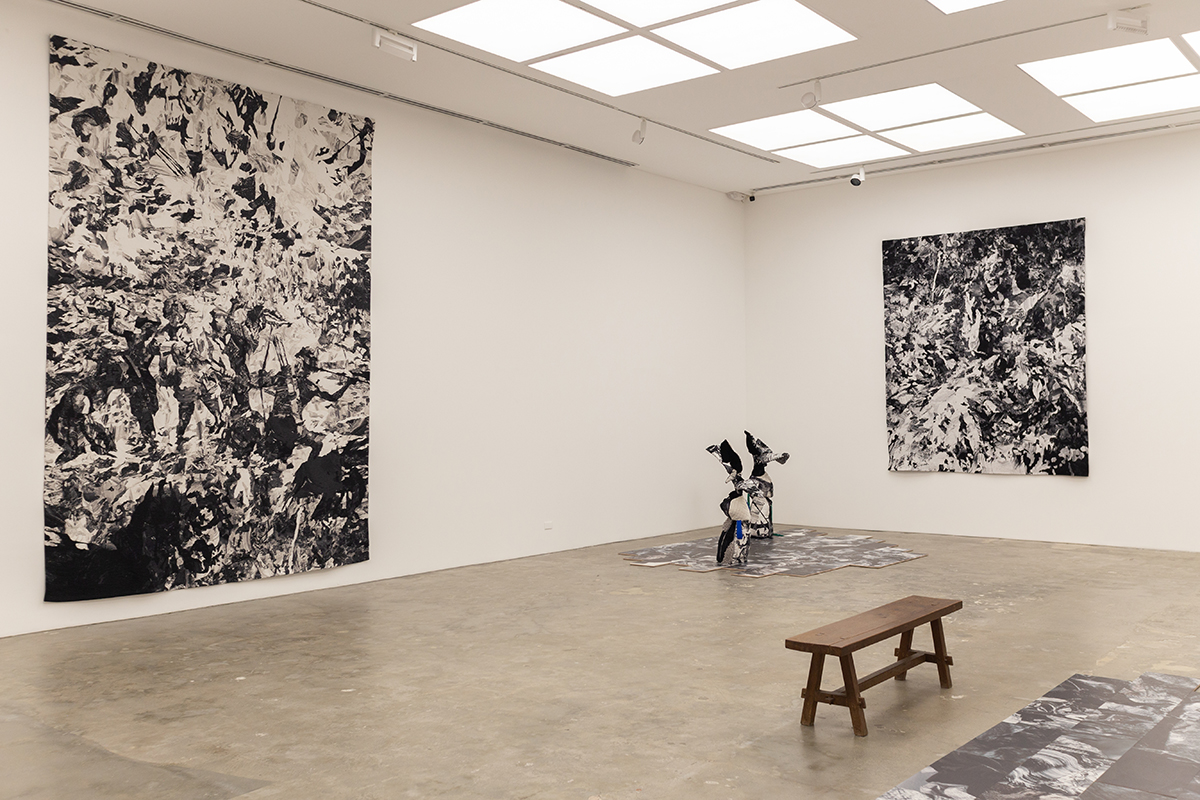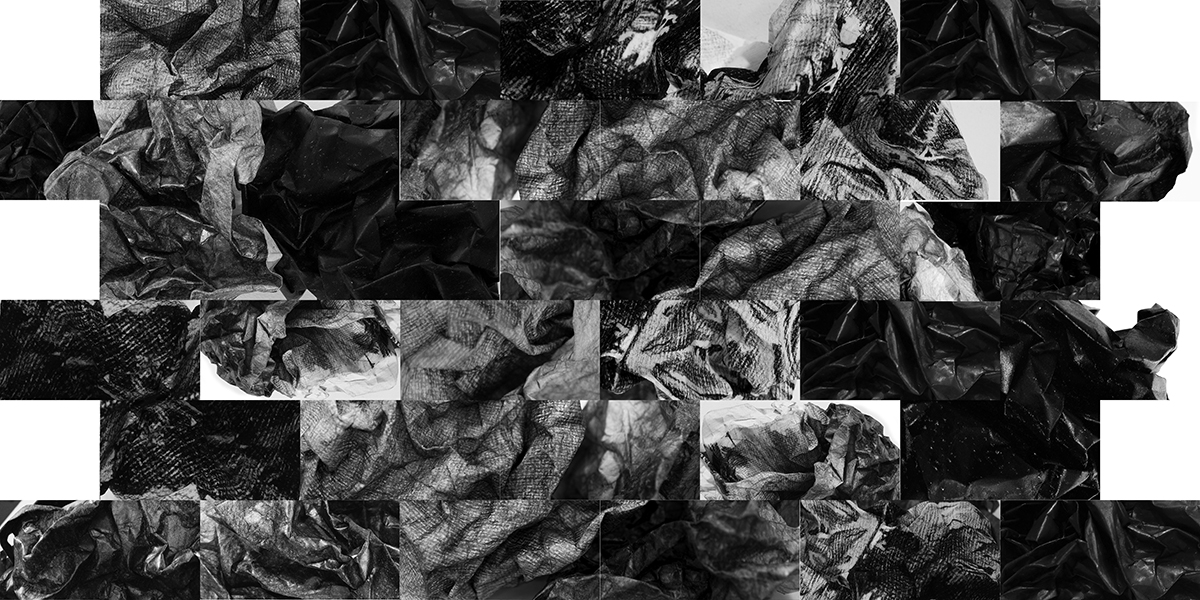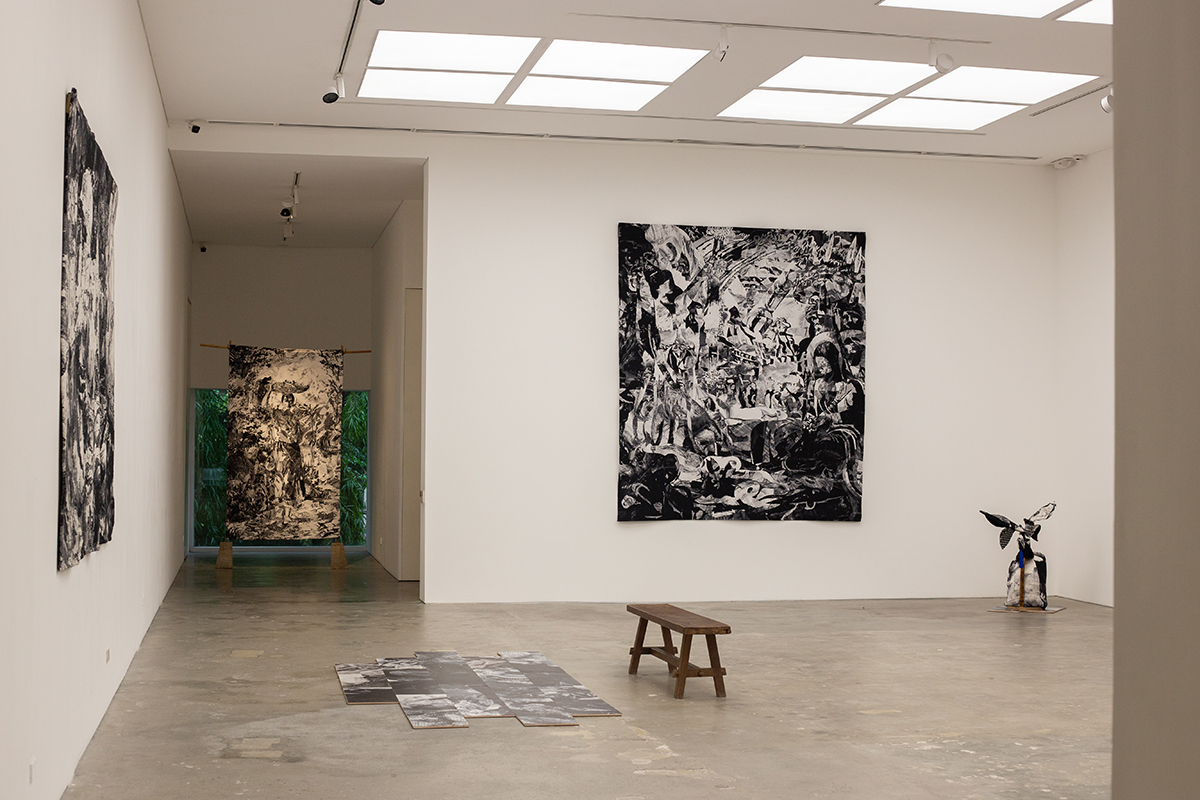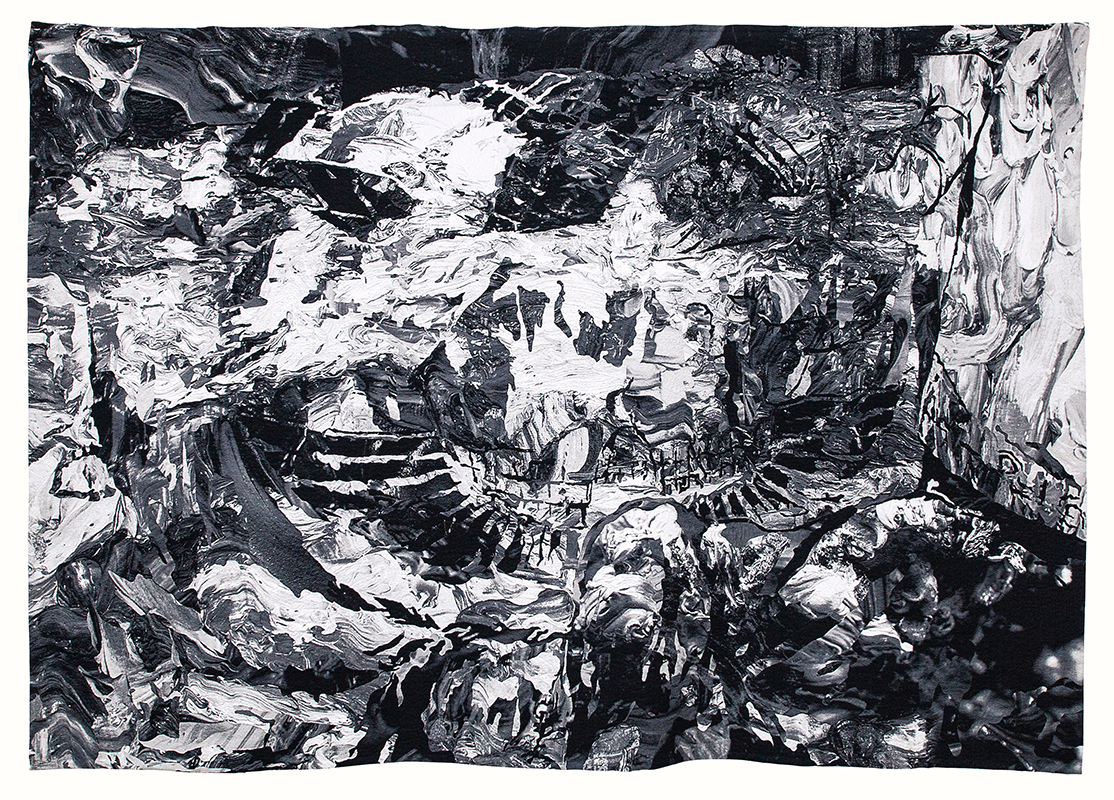Continuing until September 12 at Silverlens Galleries is Patricia Perez Eustaquio’s Hoarding Fossils in Blankets. Featured alongside her Endless Summer soft sculptures and a selection of her Boom paintings are six new tapestries, the first of a long series the acclaimed artist intends to undertake. “Translations,” as she calls them, each textile is an outcome of an art canonical painting by a Philippine master, reworked and reinterpreted via photography and digital loom. The original colors have been pared down to black and white, while the iconic figures remain recognizable only by their shadows.
The immediate impression the tapestries have is sheer enormity, held in reserve. While the tapestries tackle themes surrounding history, cultural appropriation, art, the migration of such art across the globe, and likely more, we wanted to hone the conversation on the medium capable of hosting that tight network of ideas: textile, how the artist managed it, and what it means for her to think of them as translations.
C: In the tapestries of Hoarding Fossils in Blankets, there are a lot of threads to follow: ownership, our postcolonial reality, textile and painting as gendered mediums… What prompted you to tackle these themes together and predicate them under the idea of translation?
PE: The internet has given our age an almost unlimited access to information and, I think that has allowed us to look back at history to reassess what has brought us to this point. Having more access has allowed us to trace the connection of one story to another, and another and so on. It is overwhelming and in a sense I wanted to work along that feeling.
Speaking for myself, there are so many interesting aspects of history that were either ignored or intentionally left out from my education that reading about how Filipino pirates traded pearls for British knives, for example, was a surprise to me. Or how a 17th century Peruvian tapestry could be embroidered on silk from China that arrived in Mexico from Manila. That objects that have migrated embody so much history is something I wanted to highlight.
Art history, of course, is only part of this greater, complex (world) history. When we look at art history, we see, too, how much art and art works have evolved. I wanted to reassess some of those works and translate and transpose them into the now because it was possible, and because I wanted to see where we could end up.
They say art is a kind of language, and in my work, I translate the original into a version of itself in photography, and then again in tapestry. Each medium has its own language. In a way it is the same work, but then again, it is not.
C: Did calling the tapestries “translations” cause a shift, also, in how you see yourself as an artist?
PE: I’ve always worked along the idea of perception. How our minds operate and how our memories taint how we perceive things. In my art practice, I look at our visual culture and the objects that litter it. I like to question how they are made, when they were made, in what context and so on. The form, the medium, the aesthetics all influence the way we see them and what ideas or stories or even feelings we attach to them. Over the years I’ve shifted my focus on these different areas, exploring how each evolves or comes to be. In a way, throwing many things onto a single work allows us to dissect its many layers of references over time.
C: “It is overwhelming and in a sense I wanted to work along that feeling.” I think this sentiment is what resonates with me the most as a viewer of your works: this idea of overloading the textile as a medium—or “interface,” as you call it in your catalogue essay.
How you proceed afterward becomes especially fascinating to me, here. In the succeeding paragraphs of your writeup, you explain how you sought to make an object far-removed from the “thing-in-itself”; that the process of translation is interrogated, or how these appropriations “evolve,” is more important to you than it is about enclosing them under a singular, surrogate meaning. To the point, even, that seeking that closure ends up revealing itself as a kind of vanity.
This, to me, might be the most remarkable feature in your use of textiles: how tugging at one “thread” reveals how tightly enmeshed it is in all the others, as it is with, maybe, the conception of the individual self. Is this a good foothold for us to understand the kind of world view you would like to espouse, in contrast to how you described painting?
PE: In a sense, yes. I describe painting in my Artist Statement as it is seen in art history, which is a view still held by many today. Of course “painting” has departed from this tradition many times. And yet many times we observe that we are still here.
In any case, yes! There is something that makes sense about Being and Time, and perhaps in my own worldview I have adopted its thesis loosely. But the potential of ideas given space and time is endless as long as we have both. It's a little more difficult to think about things now when the balance is lopsided: we have so little space and so much time. But now, more than ever, we realize how connected we are: that the world is a tangled mass/mess hurtling through history. We ignore the little parts, the small things, but we can see quite clearly at this point in time how every small thing matters, or can matter. The only problem is we're still blind to those “small” things, to those things that have been marginalized for a long time. I have mentioned that art, among many things, is about perception. As an artist, my work proposes a loose equation of things that I believe have been ignored.
C: So, how long does it usually take for you to complete a tapestry? Can you walk us through your creative process?
PE: At first there was the technical side of tapestry I had to understand and working with the weavers that we needed to get just right. This took about two years. (Really.) Finally getting the contrast and details right took a really long time. The six tapestries in the show all together took two more years to complete, so four in all. So, each took about 3 months from start to finish. The images themselves take about a month to make. I work on a file that is true to size so my files are in GB not MB. Sometimes I have to paint more to get more of the photos I want to use. To get a particular kind of gray, for example, I had to make a painting reference in yellow and photograph it in black and white. Doing it direct in black and white just wasn’t the same.
C: Given how long it takes to complete one tapestry, are there set criteria for you to decide what historical painting to translate? And will the series follow this one-to-one ratio of one tapestry per painter? If so, why choose the paintings that you did, like Luna’s Death of Cleopatra over Spoliarium, for example?
PE: There are no set criteria; I change my mind too often. For the five, however, I did want to choose works depicting women. The only duplicate artist is Amorsolo, who also painted the Death of Magellan, also the only tapestry without a woman in the imagery.
I chose Death of Cleopatra because it so happened at that time I was in an art residency in Gasworks in London, and I was spending a lot of time at the V&A and the British Museum looking at objects that had travelled from all corners of the world. I encountered the alleged mummy of Cleopatra along with all the other Eqyptian artefacts at the British Museum, and I was awestruck at the magnitude of the haul. Coincidentally at this time, too, the National Gallery of Singapore had a Juan Luna exhibition featuring the artwork, which is in the collection of the Prado Museum in Spain and had never been exhibited in the Philippines. It is a beautiful painting, but I thought, if this painting were made today, the artist would be accused of cultural appropriation. How things change! Would I agree? I don't know, but I found that conflict interesting.
Since I had started with Cleopatra, I wanted to continue choosing works that had a female subject, or object, if you prefer. Botong's Babaylan came next because I love the energy of the witch doctor in that work, and Botong was so different from Luna stylistically that it was a nice challenge of translation.
I don't want to set a limit per painter, but I do want to explore many other artists works and see how the ideas and styles all work out in the translation. That said, there are other artworks I started work on that just didn't come out right. I spent a month on a study of a painting of one of the Moderns which then went into the trash bin. But these mistakes you just take with you so you learn and try something else next time, right?
Pat Eustaquio’s Hoarding Fossils in Blankets continues at Silverlens until September 12, alongside the eponymous exhibition of Dashiell Manley. For appointment bookings, click here. Contact info@silverlensgalleries.com or visit the website for more.






